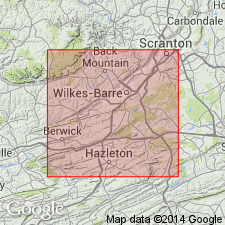
- Usage in publication:
-
- Mill Creek limestone
- Modifications:
-
- Named
- Dominant lithology:
-
- Limestone
- AAPG geologic province:
-
- Appalachian basin
Summary:
Name Mill Creek limestone introduced here for siliceous, ferruginous, and extremely hard limestone, 12 to 15 in. thick that crops out along north side of Mill Creek, near Wilkes Barre, northeastern PA. Lies 25 to 30 ft higher than Canal limestone and 30 ft below Joe Gibbs coal, separated from both by sandstone. Age is late Carboniferous.
Source: GNU records (USGS DDS-6; Reston GNULEX).

- Usage in publication:
-
- Mill Creek limestone
- Modifications:
-
- Overview
- AAPG geologic province:
-
- Appalachian basin
Summary:
According to author there is little doubt that Mill Creek limestone, near summit of anthracite coal series in Wilkesbarre basin, represents same geologic plane as Ames limestone, since nearly every species described from it by A. Heilprin is found in Ames limestone near Morgantown, WV.
Source: GNU records (USGS DDS-6; Reston GNULEX).

- Usage in publication:
-
- Mill Creek Limestone
- Modifications:
-
- Biostratigraphic dating
- AAPG geologic province:
-
- Appalachian basin
Summary:
Conodont evidence indicates that the accepted correlation of the Pennsylvanian Mill Creek Limestone in northeastern PA with the Ames Limestone of western PA and WV is incorrect. The correlation was suggested by White (1903) and corroborated by Chow (1951) who analyzed the Mill Creek fauna in more detail. Several additional Conemaugh marine units have since been discovered, some of which are potential correlation targets for the Mill Creek, among them the Noble Member. Analysis of conodonts in this study reveal that the Mill Creek population is distinctly older in an evolutionary sense than any similar population seen in the Ames. It is concluded that not only is the Mill Creek not coeval with the Ames, it is actually older than the Noble Limestone in eastern OH, and may have no exact correlative elsewhere in the Appalachian basin. The possibility exists that the Mill Creek may have originated far to the east and been overthrust to its present location or that it may have originated on a tectonic plate other than the one on which it is presently found.
Source: GNU records (USGS DDS-6; Reston GNULEX).
For more information, please contact Nancy Stamm, Geologic Names Committee Secretary.
Asterisk (*) indicates published by U.S. Geological Survey authors.
"No current usage" (†) implies that a name has been abandoned or has fallen into disuse. Former usage and, if known, replacement name given in parentheses ( ).
Slash (/) indicates name conflicts with nomenclatural guidelines (CSN, 1933; ACSN, 1961, 1970; NACSN, 1983, 2005, 2021). May be explained within brackets ([ ]).

